Introduction
Indonesia is the second world’s largest fisheries producer (FAO, 2020), with coral reef fisheries contributing to Indonesian fisheries productivity, estimated to reach a total of 800 thousand tons annually (MMAF, 2022). As a result, coral reef fishes are economically important commodities in Indonesia, demanded by domestic and international markets, such as Singapore and Hong Kong (Rizal et al., 2018). However, due to its high demand, populations of some reef fish species are threatened across the country (Campbell et al., 2013).
Reef fish of the family Lethrinidae (emperors) are abundant in tropical and subtropical regions where coral reefs, seagrass beds, and mangrove forest areas are their habitats (Young & Martin, 1982). Fishes within the family are one of the significant food resources in the Western Pacific and Indian Oceans due to their high catch amount (Carpenter & Allen, 1989). Among the lethrinids, the Lethrinus atkinsoni, known as pacific yellowtail emperors, is a highly targeted fish by local fishers in Indonesia (Mayunar, 1996), including in the Southern Sulawesi region (Agustina et al., 2021). There are numerous studies concerning the growth and biological parameters of the L atkinsoni (Currey et al., 2013; Ebisawa, 1999; Prihatiningsih et al., 2021; Rumania et al., 2020), while no studies yet about the status of its stock in Indonesia, particularly in the Southern Sulawesi region.
About 90%–95% of fishers in Indonesia are small-scale yet generating significant contributions for coastal communities (Sari et al., 2021). Small-scale fisheries often referred to as artisanal fisheries, is a traditional fishery that involves fishing households and uses relatively small fishing vessels and short fishing trips. The catch is mainly for local consumption. Most fishers in Southern Sulawesi are small-scale, contributing significantly to social and economic conditions in the area as the primary source of livelihood, providing food for the community. The fishers and the local community are dependent on fish resources. Accordingly, they are vulnerable to any change that disrupts their harvest (Wiyono, 2011). Therefore, effective management of small-scale fisheries in the area is crucial for the community.
Southern Sulawesi is one of Indonesia’s crucial regions for coral reef fisheries, where the world’s 3rd most extensive coral reef atoll is found (Malik et al., 2018). The coral reefs are home to more than 500 reef fish species, including the highly demanded reef fish emperors of the family Lethrinidae (Muhidin et al., 2019). However, the coral reefs there are being threatened due to destructive fishing activities by explosives and cyanide (Panuluh et al., 2020). Despite being one of the most important fishery commodities in Indonesia, the potential of lethrinid fish and its utilization status are still poorly understood (Restiangsih & Muchlis, 2019). In addition, the impact of fishing activities in Southern Sulawesi is not yet fully known due to limited data (Agustina et al., 2021). This limited status and trend certainly affect fishery management, hampering its resources to be sustainably managed (Rizal et al., 2018). In this context, identifying biological characteristics and assessing the stock condition of lethrinid fish is necessary to improve fisheries management in the area. This study aims to assess the stock status of L. atkinsoni in Southern Sulawesi, Indonesia. The species’ biological characteristics and stock conditions were investigated using the length-based stock assessment approach.
Materials and Methods
This study was conducted in Southern Sulawesi, Indonesia (Fig. 1), from January to October 2022. A total of 4,887 individuals of L. atkinsoni (Fig. 2) were collected from three landing sites; the Tarupa Besar, Rajuni Kecil, and Latondu Besar. The samples were commercially caught by small-scale handline and speargun fishers. The samples were measured to the nearest millimeter in total length.
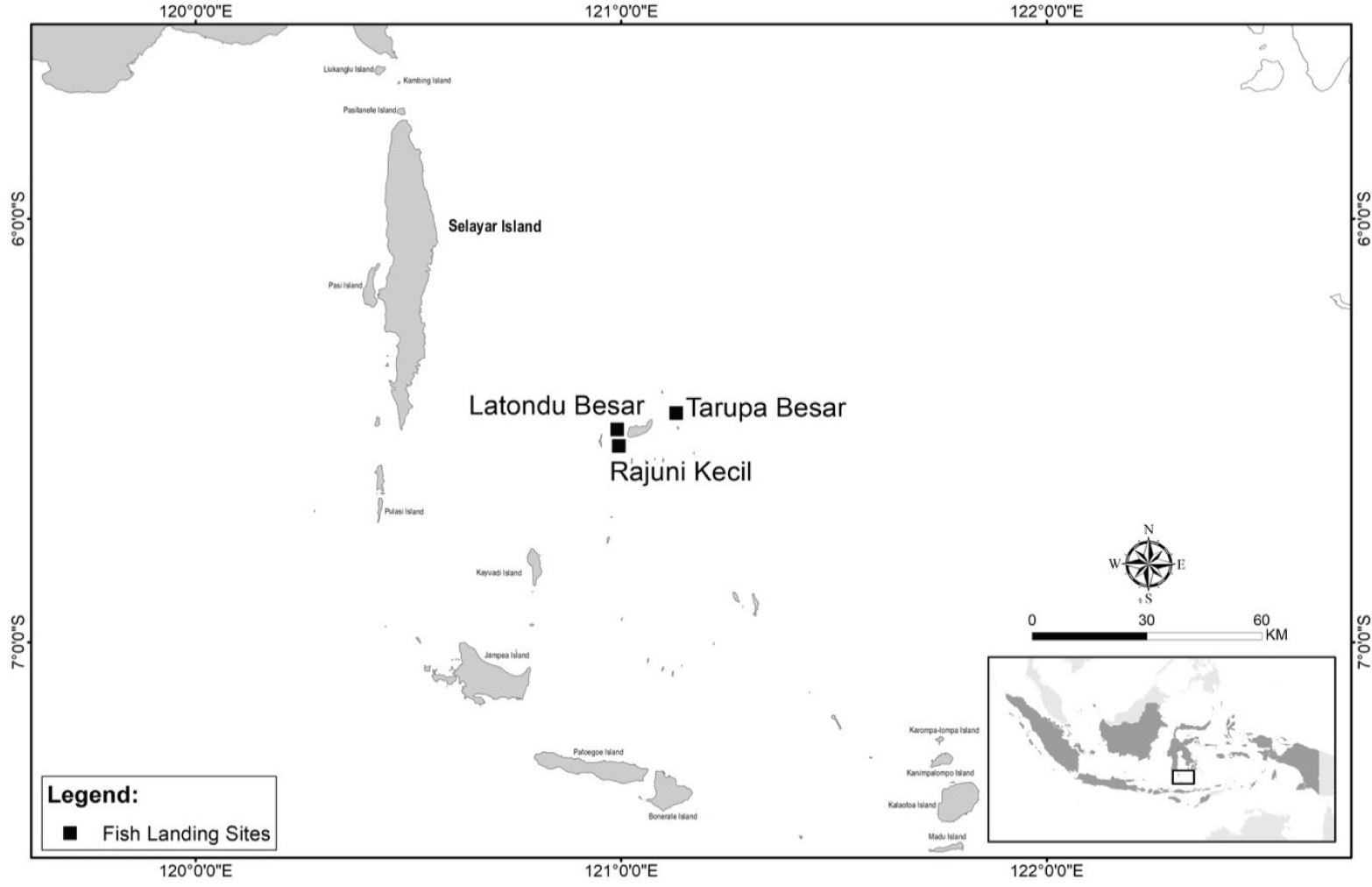
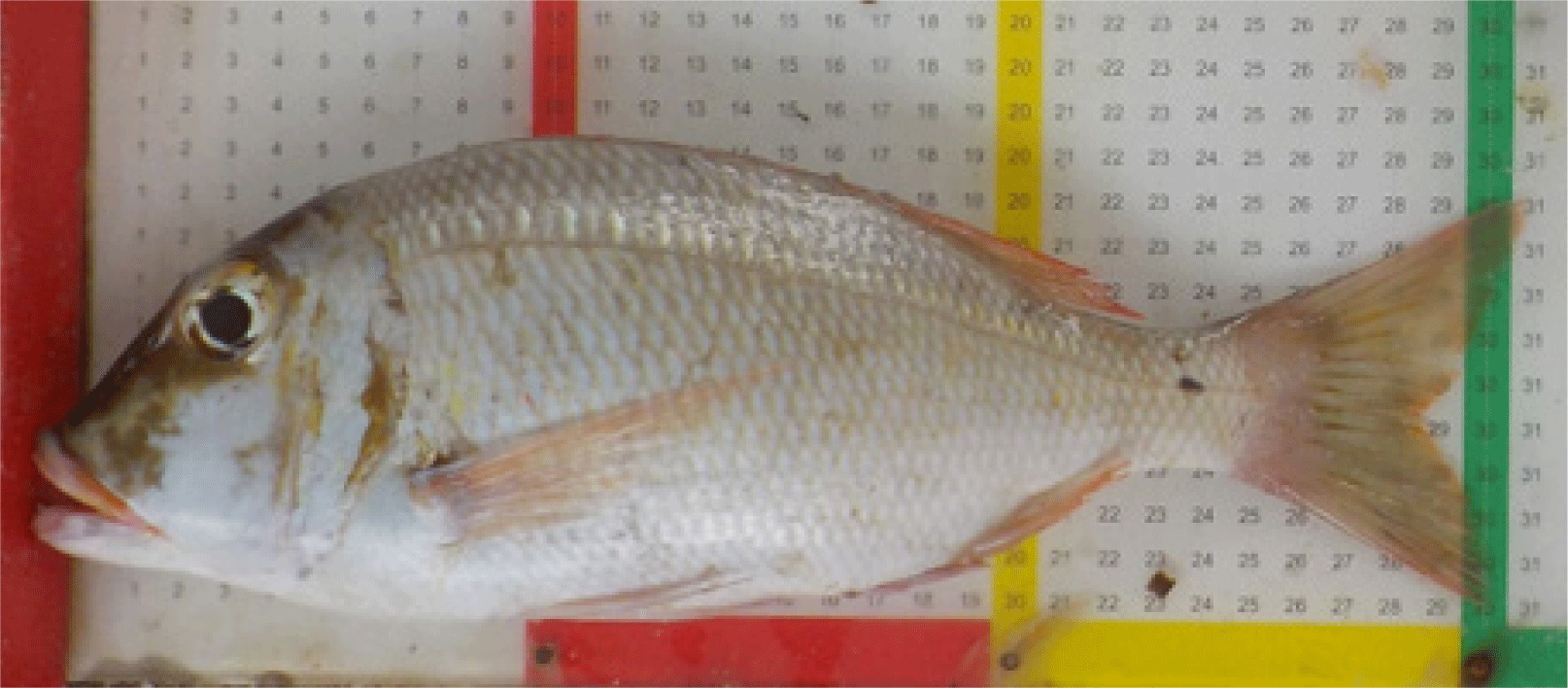
From those total samples, in April and May 2022, 152 individuals of L. atkinsoni were examined for their sex and gonad maturity following West (1990). The sex of each sample was determined through macroscopic examination after dissection, whereby the shape and color of the testis and ovaries were used to assign the gonadal maturity of the fish.
The sex ratio of L. atkinsoni was estimated and tested for the significant differences in the proportion of males and females for a theoretical 1:1 relation using a Chi-square (χ2) equation (Kenney & Keeping, 1951) following the formula:
Where O is the observed number of males and females; E is the expected number of males and females.
We assessed the fish stock using the length-based spawning potential ratio (LBSPR) model (Hordyk et al., 2015). The life-history parameters and length frequency distribution data were examined as its input. The life-history parameters consist of growth coefficient (k), asymptotic length (L∞), natural mortality (M), length at first capture (Lc) and length at first maturity (Lm). Growth parameters (i.e., k and L∞) were estimated by the von Bertalanffy growth model (Sparre & Venema, 1998) using the “TropFishR” package in Rstudio (Mildenberger et al., 2017), following the formula:
Where L∞ is the mean maximum length, k is a growth coefficient, and t0 is the theoretical age at a size 0.
M was calculated following the Pauly empirical equation (Pauly, 1980):
Lm was analyzed following the formula of Spearman-Karber (Udupe, 1986):
With 95% confidence interval, it was calculated as:
Where: m = log of fish length at first mature gonad; Xk = log of mean length value at first mature gonad; X = log of median of last length at first mature gonad; X = log of increased length of the fish at the median; Pi = the proportion of mature gonad at the interval of ith with the number of fish at the interval of ith; ni = number of mature gonad at the interval of ith; qi = 1 – pi; M = antilog m of the length of first matured gonad.
The Lc was analyzed based on the logistic curve from the selection ogive function (Sparre & Venema, 1998). The recruitment pattern was estimated by backward projection using length frequency distribution data based on the von Bertalanffy growth curve (Mildenberger et al., 2017; Pauly, 1984).
Results
The length range of L. atkinsoni was from 10.5 to 39.5 cm, with most individuals observed within the 22–24 cm size class (Fig. 3) with an average length of 23.25 (± 3.93 cm).
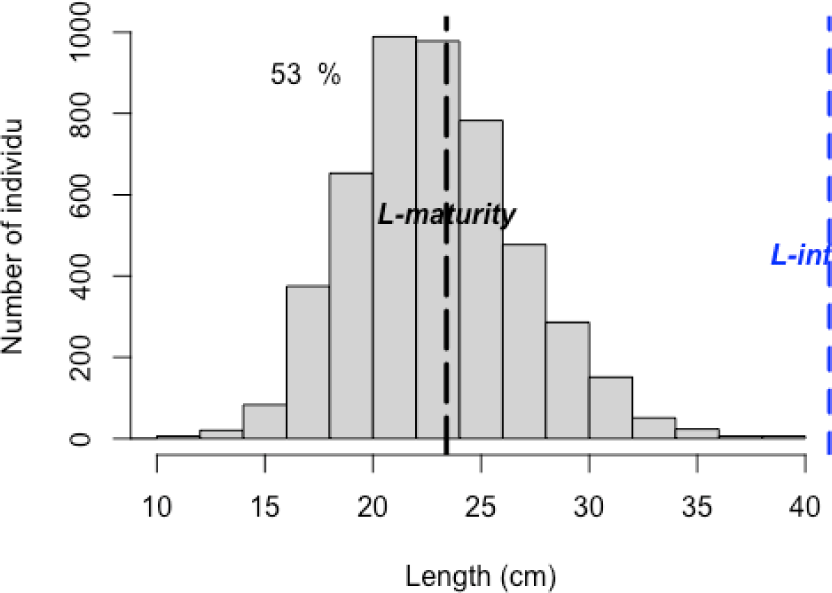
From 152 samples of L. atkinsoni that were collected for gonad investigation, we found 83 female and 69 male individuals. The sex ratio (male:female) was 1:1.2, with the observed proportion was statistically not significantly different (p > 0.05).
We observed that the L∞ of L. atkinsoni was 41.14 cm (Table 1). The k of the species was 0.45/year, indicating a high growth rate (k > 0.3; Froese, 2005). The M of the species was 0.6/year, with theoretical age at length 0 cm (t0) was –0.33 years (Table 1). The Lm of the species was 23.40 cm, with the Lc was 19.59 cm (Table 1 and Fig. 4). Based on the LBSPR model, we observed that the spawning potential ratio (SPR) of the L. atkinsoni in Southern Sulawesi was 12%, indicating an unsustainable level of the stock condition (SPR < 30%) (Ault et al., 2008).
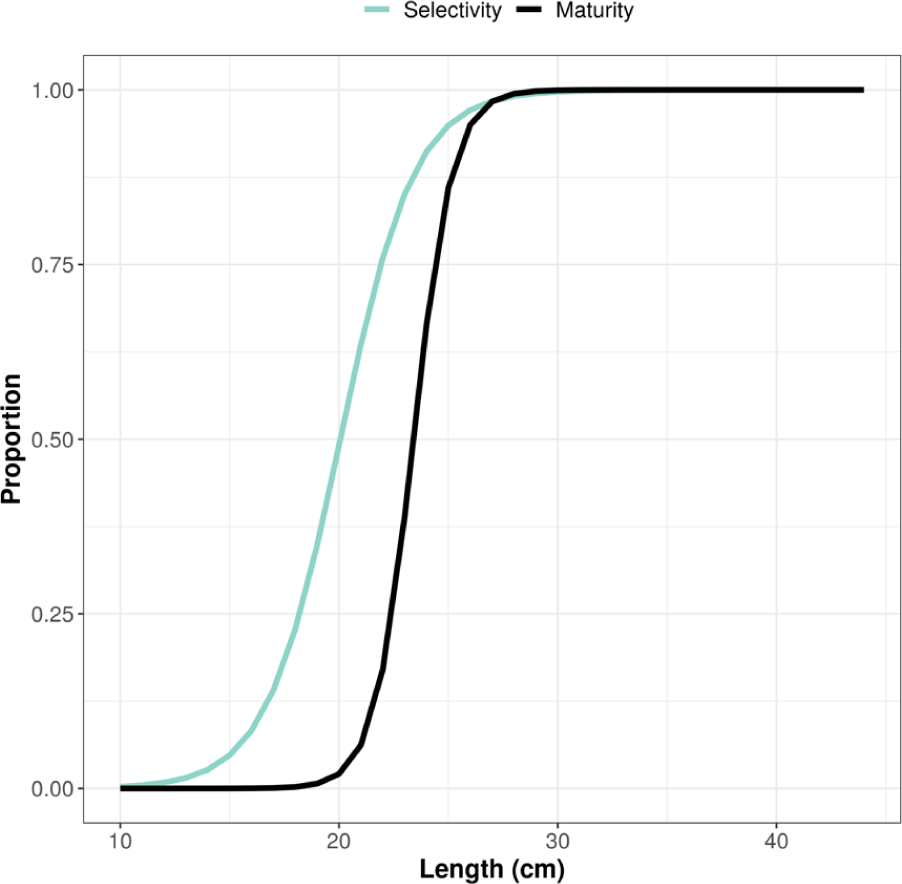
We observed that L. atkinsoni in Southern Sulawesi was a partial spawner, with a range of monthly recruitment of 2%–15 % (Fig. 5). The peaks of recruitment were observed in April (15%), July (15%) and November (12%). The recruitment patern occurring in these months is likely influenced by the annual upwelling event in the respective area (Utama et al., 2017). According to Klein et al. (2018), the recruitment pattern revealed a strong relationship with the upwelling.
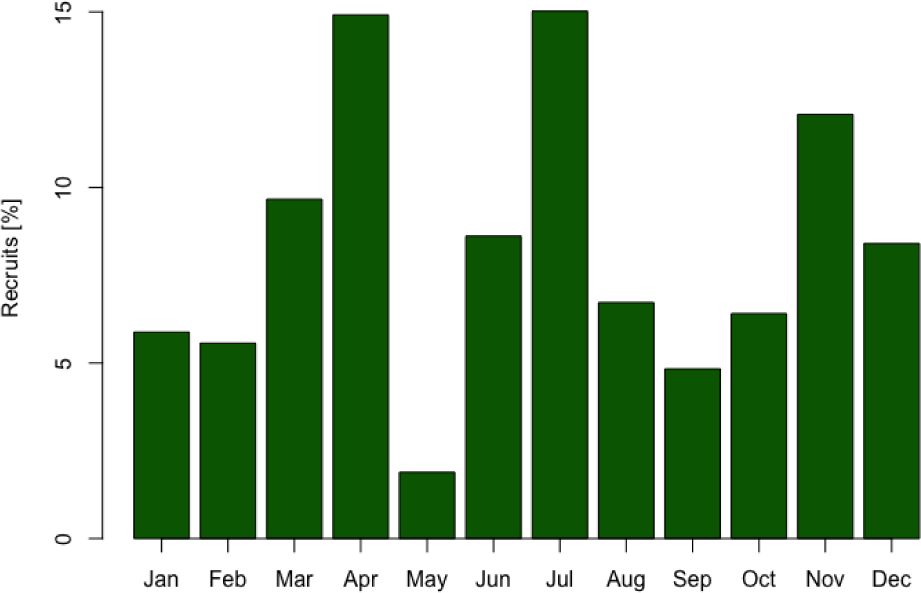
Discussion
This study is the first finding of the length-based stock assessment of L. atkinsoni, the pacific yellowtail emperor, in Southern Sulawesi, Indonesia. We provide scientific information regarding the biological characteristics of the species, providing valuable input for fisheries management in the region. Based on the biological characteristics, we found that the population of this emperor was harvested at an unsustainable level.
The length range of the L. atkinsoni in Southern Sulawesi was from 10.5 to 39.5 cm. In other sites within Indonesia, the ranges of the conspecific were from 15.1 to 32.5 cm and from 12.0 to 37.7 cm in East Seram (Rumania et al., 2020) and Wakatobi (Prihatiningsih et al., 2021), respectively. In the Great Barrier Reef, Australia, the maximum length reported was 48 cm (Currey et al., 2013). While the range was similar among sites within Indonesia, the length of the fish was relatively smaller compared to the conspecific in Australia (Currey et al., 2013). This discrepancy might be due to ecological and environmental conditions between Indonesia and Australia, such as water quality, genetics, catch rate, and food abundance (Nikolskii, 1963), which can affect the biological condition of the fish.
In the present study, we found that the sex ratio of L. atkinsoni in Southern Sulawesi was equal between male and female individuals. Similarly, the sex ratio of the conspecific in the Wakatobi was equal (sex ratio male:female = 0.55:1.00; Prihatiningsih et al., 2021). Variations in the sex ratio can be affected by several factors, including behavior patterns, mortality, and growth rates between male and female individuals, spawning behavior, sexual maturity, length distribution due to its depth ranges, and length (or age) of the individuals (Effendie, 1997; Nikolskii, 1963). However, a note should be taken into consideration that L. atkinsoni is protogynous hermaphroditism species, with the length of sexual transition was reported between 23.0 and 23.9 cm fork length (FL) off Yaeyama and between 30.0 and 30.9 cm FL off Okinawa (Ebisawa, 1999). In protogynous species, the exact effect of fishing pressure on stock dynamics is complex (Alonzo & Mangel, 2004). In the case of the present study, no data on sexual transition length was reported on the species from the area. Accordingly, further measures of fishery management for the species might be challenging.
We observed that the k of L. atkinsoni was 0.46/year, with an L∞ of 41.14 cm. Based on Froese (2005), the k value of a higher growth rate is above 0.3/year. In areas close to the equator (i.e., tropical region), L. atkinsoni tends to have higher k values than the conspecific in higher latitudes (Table 2). Higher annual seawater temperatures in the tropic might affect the higher growth rate of L. atkinsoni (Gislason et al., 2010).
| Location | Asymptotic length (cm) | Growth coefficient (/year) | References |
|---|---|---|---|
| Yaeyama, Japan | 30.9 (FL) | 0.186 | Froese & Pauly (2022) |
| Great Barrier Reef and Eastern Torres Strait, Australia | 32.5 (FL) | 0.32 | Froese & Pauly (2022) |
| Northern coast, Fiji | 42.8 (SL) | 0.29 | Froese & Pauly (2022) |
| Okinawa, Japan | 35.1 (SL) | 0.26 | Froese & Pauly (2022) |
| Great Barrier Reef, Australia | 32.2 (FL) | 0.32 | Currey et al. (2013) |
| Wakatobi, Indonesia | 38.2 (FL) | 0.44 | Prihatiningsih et al. (2021) |
| East Seram, Indonesia | 34.2 (TL) | 0.42 | Rumania et al. (2020) |
| Southern Sulawesi, Indonesia | 40.5 (TL) | 0.40 | This study |
The Lm of L. atkinsoni in Southern Sulawesi was 23.40 cm at the age of approximately 1.5 years. The Lm in the present study was relatively lower compared to the conspecific in the Wakatobi (Lm for male = 30.7 cm; Lm for female = 27.18 cm; Prihatiningsih et al., 2021) but relatively higher in Japan (Ebisawa, 1999) with the Lm of 19 cm FL off Yaeyama and 21 cm FL off Okinawa. The Lm discrepancy was presumably due to the influence of environmental factors, including nutrient conditions, seawater temperature, irradiation, as well as species feeding habits and physiological conditions of fish, and the location of the fishing ground (Lagler et al., 1963; Udupe, 1986; Wootton, 1985). Latitudinal difference of more than 5° was thought to cause differences in age and length at first gonad maturity (Effendie, 1997). Moreover, high fishing pressure could affect the Lm, where rapid maturation was found as a strategy for fish populations to cope with high fishing pressure (Restiangsih & Amri, 2019). The rate of fishing pressure in Southern Sulawesi is relatively higher than in Wakatobi (Fatma et al., 2021). To maintain its population, L. atkinsoni in Southern Sulawesi was likely to follow a similar strategy where they tend to have rapid maturation to cope with high fishing pressure.
We observed that the average size of the Lc of L. atkinsoni in Southern Sulawesi was 19.59 cm at the age of approximately 1.1 years. The Lc was lower than the Lm, indicating that local fishers in Southern Sulawesi also caught a proportion of immature individuals (Fig. 4). Based on the size frequency distribution (Fig. 3), about 53% of immature individuals were caught by the local fishers. In addition, we found that the peak of recruitment of L. atkinsoni occurred in April, July, and November. This information can predict the spawning period of L. atkinsoni in Southern Sulawesi (Agustina et al., 2019), which can provide input to fisheries managers to apply temporary fishing closure.
Based on the LBSPR model, the SPR of L. atkinsoni in Southern Sulawesi was 12%, indicating that the population was harvested at an unsustainable level. The low SPR values (< 30%) can reduce the ability of spawning stock biomass to produce adult stock in the structure of the population (Ault et al., 2008). This low SPR reflects a reduction in the number of young fish, thereby triggering a decrease in spawning stock and limiting the number of eggs produced. The SPR, as the biological reference point, is used to define safe levels of fishery harvesting and as benchmarks against which the actual status of a fish stock can be measured (Collie & Gislason, 2001). Management actions to rebuild the biomass of the species are needed to increase SPR above the threshold (> 30%), which can be achieved by reducing fishing intensity, temporary fishing closure, and regulating the harvest size limit. Further management actions are needed to rebuild the stock of the species in the area to ensure a sustainable fishery.








